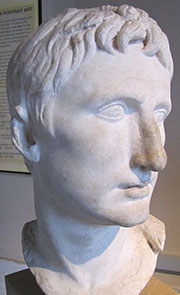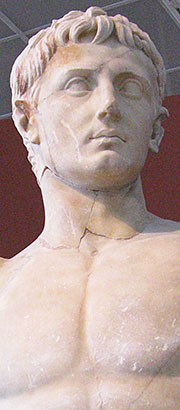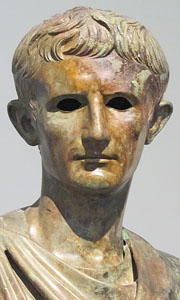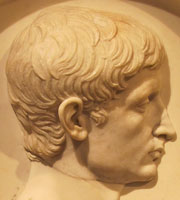Emperor Augustus (Imperator Gaius Julius Caesar Augustus, 63 BC - 14 AD, reigned 27 BC - 14 AD).
This head [1], probably originally part of a life-size statue, appears very different from other surviving portraits of Augustus. He has been given a larger nose (a modern restoration?) and a softer, more feminine mouth than usual, as well as a typical Hellenistic, Pergamese "ruffled" hairstyle, perhaps in imitation of Alexander the Great (see gallery 2, page 2) and his successors, such as Attalus I.
During his lifetime, official portraits of Augustus showed him as a young man. His successors had sculptures made showing him older and more mature.
Born Gaius Octavius Thurinus (he is usually referred to as Octavian), he was adopted posthumously by his great uncle Julius Caesar in his will. Following the assassination of Caesar in 44 BC, Octavian fought for control of Rome, first against the Republican assassins (particularly Brutus and Cassius), and later Marc Antony and Cleopatra VII of Egypt. (See also Athens Acropolis gallery page 8).
His victories over his adversaries made him sole ruler of Rome, and effectively the first Roman Emperor. He was voted the title "Augustus" (the revered one) by the Roman Senate in 27 BC. He deified Caesar, styled himself "Imperator Caesar divi filius" (Commander Caesar, son of the deified one) and invented the new Julian family line.
The Latin title Augustus, which became synonymous with that of emperor, was known in Greek as Sebaston (σεβαστός, sebastos, venerable; from σέβας, sebas, awe, reverence, dread). This title began appearing on Pergamese coins during the Roman Imperial period.
Unlike the Romans, who still deeply distrusted the very notions of kings and living gods, the Pergamese were long accustomed to revering their Attalid kings as deities, and were keen to impress their new ruler Augustus by offering him the same honour. They set up a choir known as "hymnodoi of the god Augustus and the goddess Rome", consisting of 40 men who sang the emperor's praises without pay. The emperor was indeed so impressed that he made the choir permanent and hereditary, paid for by a levy on the entire province of Asia. The Hymnodoi were still being mentioned well into 2nd century BC. [2]
The last words of Augustus are said to have been, "Have I played the part well? Then applaud as I exit". Officially, his last words, no less theatrical, were, "Behold, I found Rome in bricks, and leave her to you in marble," referring to the legacy of his building projects in the city, or perhaps to the empire's increased power. At his funeral, his successor Tiberius (see next gallery page) confirmed his deification, thus establishing the first cult of the Roman emperors.
The Greek cities of Asia Minor, such as Pergamon, Smyrna and Ephesus, competed for the honour and prestige of becoming the official centre of these imperial cults for the new Roman province of Asia. Such centres were known as neokoroi, from the Greek νεωκόρος, neokoros, temple-keeper. [3]
Pergamon was granted the neokoros for the cult of Augustus and Roma, the patron goddess of Rome and personification of the Roman Public and Senate. [4] This was the first of three neokoroi the city was to be awarded. [5] According to the Roman historian Cassius Dio, Augustus had permitted Pergamon to set up a sacred precinct to himself as early as 29 BC [6], and a temple was built for the cult. To show off its status as neokoros, Pergamon issued coins bearing the image of Augustus standing in front of a temple with a portico of six columns (hexastyle).
It is not known where this temple stood, and no remains of it have yet been discovered by archaeologists. It may have been destroyed by one of the many devastating earthquakes which hit the area [7], or replaced by a later building, such as the Temple of Trajan. One theory is that it stood not on the Pergamon Acropolis but in the new city district Augustus had built, based on a grid system, below the Acropolis, on the banks of the Selinus river. Much of this district now lies beneath the old town of Ottoman houses, around the "Red Basilica", in the north of Bergama. |

The Augustus head from
a different angle. |
| |

A more conventional depiction
of Augstus as a youthful hero
in Classical/Hellenistic style.
Detail of a full-length statue,
perhaps been made in
Thessaloniki during the reign
of Tiberius (see next page).
Thessaloniki Archaeological Museum. |
| |

Detail of a statue of Augustus. Fragmentary bronze equestrian
statue, 12-10 BC, found in the
Aegean Sea between the
islands of Euboea and Agios
Efstratios, Greece.
National Archaeological
Museum, Athens.
Inv. No. X. 23322. |
| |

Relief head of Augustus
showing signs of age.
Such depictions were used
only during the reigns of his
successors, Tiberius, Caligula
and Claudius.
Marble. Rome, 30-50 AD.
Altes Museum, Berlin.
Inv. No. Sk 1345. |
|